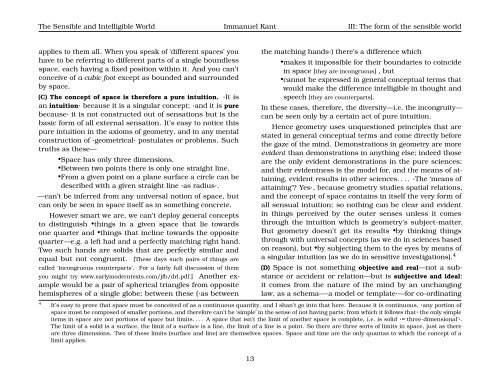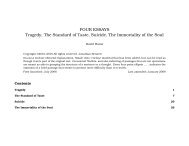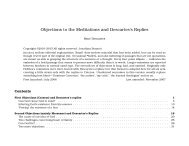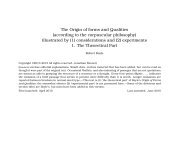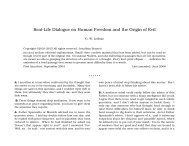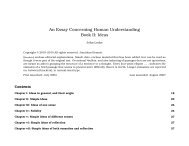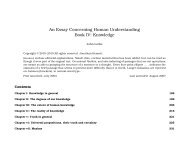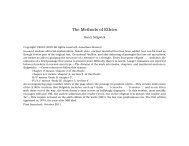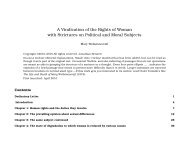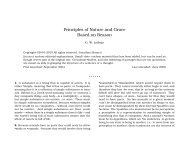The Form and Principles of the Sensible and Intelligible World
The Form and Principles of the Sensible and Intelligible World
The Form and Principles of the Sensible and Intelligible World
You also want an ePaper? Increase the reach of your titles
YUMPU automatically turns print PDFs into web optimized ePapers that Google loves.
<strong>The</strong> <strong>Sensible</strong> <strong>and</strong> <strong>Intelligible</strong> <strong>World</strong> Immanuel Kant III: <strong>The</strong> form <strong>of</strong> <strong>the</strong> sensible world<br />
applies to <strong>the</strong>m all. When you speak <strong>of</strong> ‘different spaces’ you<br />
have to be referring to different parts <strong>of</strong> a single boundless<br />
space, each having a fixed position within it. And you can’t<br />
conceive <strong>of</strong> a cubic foot except as bounded <strong>and</strong> surrounded<br />
by space.<br />
(C) <strong>The</strong> concept <strong>of</strong> space is <strong>the</strong>refore a pure intuition. ·It is<br />
an intuition· because it is a singular concept; ·<strong>and</strong> it is pure<br />
because· it is not constructed out <strong>of</strong> sensations but is <strong>the</strong><br />
basic form <strong>of</strong> all external sensation. It’s easy to notice this<br />
pure intuition in <strong>the</strong> axioms <strong>of</strong> geometry, <strong>and</strong> in any mental<br />
construction <strong>of</strong> ·geometrical· postulates or problems. Such<br />
truths as <strong>the</strong>se—<br />
•Space has only three dimensions.<br />
•Between two points <strong>the</strong>re is only one straight line.<br />
•From a given point on a plane surface a circle can be<br />
described with a given straight line ·as radius·.<br />
—can’t be inferred from any universal notion <strong>of</strong> space, but<br />
can only be seen in space itself as in something concrete.<br />
However smart we are, we can’t deploy general concepts<br />
to distinguish •things in a given space that lie towards<br />
one quarter <strong>and</strong> •things that incline towards <strong>the</strong> opposite<br />
quarter—e.g. a left had <strong>and</strong> a perfectly matching right h<strong>and</strong>.<br />
Two such h<strong>and</strong>s are solids that are perfectly similar <strong>and</strong><br />
equal but not congruent. [<strong>The</strong>se days such pairs <strong>of</strong> things are<br />
called ‘incongruous counterparts’. For a fairly full discussion <strong>of</strong> <strong>the</strong>m<br />
you might try www.earlymoderntexts.com/jfb/drl.pdf.] Ano<strong>the</strong>r example<br />
would be a pair <strong>of</strong> spherical triangles from opposite<br />
hemispheres <strong>of</strong> a single globe; between <strong>the</strong>se (·as between<br />
4<br />
<strong>the</strong> matching h<strong>and</strong>s·) <strong>the</strong>re’s a difference which<br />
•makes it impossible for <strong>the</strong>ir boundaries to coincide<br />
in space [<strong>the</strong>y are incongruous] , but<br />
•cannot be expressed in general conceptual terms that<br />
would make <strong>the</strong> difference intelligible in thought <strong>and</strong><br />
speech [<strong>the</strong>y are counterparts].<br />
In <strong>the</strong>se cases, <strong>the</strong>refore, <strong>the</strong> diversity—i.e. <strong>the</strong> incongruity—<br />
can be seen only by a certain act <strong>of</strong> pure intuition.<br />
Hence geometry uses unquestioned principles that are<br />
stated in general conceptual terms <strong>and</strong> come directly before<br />
<strong>the</strong> gaze <strong>of</strong> <strong>the</strong> mind. Demonstrations in geometry are more<br />
evident than demonstrations in anything else; indeed those<br />
are <strong>the</strong> only evident demonstrations in <strong>the</strong> pure sciences;<br />
<strong>and</strong> <strong>the</strong>ir evidentness is <strong>the</strong> model for, <strong>and</strong> <strong>the</strong> means <strong>of</strong> attaining,<br />
evident results in o<strong>the</strong>r sciences. . . . ·<strong>The</strong> ‘means <strong>of</strong><br />
attaining’? Yes·, because geometry studies spatial relations,<br />
<strong>and</strong> <strong>the</strong> concept <strong>of</strong> space contains in itself <strong>the</strong> very form <strong>of</strong><br />
all sensual intuition; so nothing can be clear <strong>and</strong> evident<br />
in things perceived by <strong>the</strong> outer senses unless it comes<br />
through <strong>the</strong> intuition which is geometry’s subject-matter.<br />
But geometry doesn’t get its results •by thinking things<br />
through with universal concepts (as we do in sciences based<br />
on reason), but •by subjecting <strong>the</strong>m to <strong>the</strong> eyes by means <strong>of</strong><br />
a singular intuition (as we do in sensitive investigations). 4<br />
(D) Space is not something objective <strong>and</strong> real—not a substance<br />
or accident or relation—but is subjective <strong>and</strong> ideal:<br />
it comes from <strong>the</strong> nature <strong>of</strong> <strong>the</strong> mind by an unchanging<br />
law, as a schema—·a model or template·—for co-ordinating<br />
It’s easy to prove that space must be conceived <strong>of</strong> as a continuous quantity, <strong>and</strong> I shan’t go into that here. Because it is continuous, ·any portion <strong>of</strong><br />
space must be composed <strong>of</strong> smaller portions, <strong>and</strong> <strong>the</strong>refore can’t be ‘simple’ in <strong>the</strong> sense <strong>of</strong> not having parts; from which it follows that· <strong>the</strong> only simple<br />
items in space are not portions <strong>of</strong> space but limits. . . . A space that isn’t <strong>the</strong> limit <strong>of</strong> ano<strong>the</strong>r space is complete, i.e. is solid ·= three-dimensional’·.<br />
<strong>The</strong> limit <strong>of</strong> a solid is a surface, <strong>the</strong> limit <strong>of</strong> a surface is a line, <strong>the</strong> limit <strong>of</strong> a line is a point. So <strong>the</strong>re are three sorts <strong>of</strong> limits in space, just as <strong>the</strong>re<br />
are three dimensions. Two <strong>of</strong> <strong>the</strong>se limits (surface <strong>and</strong> line) are <strong>the</strong>mselves spaces. Space <strong>and</strong> time are <strong>the</strong> only quantas to which <strong>the</strong> concept <strong>of</strong> a<br />
limit applies.<br />
13


